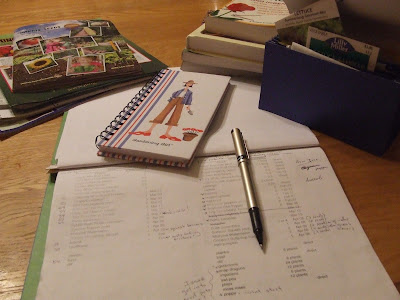I have been in the midst making my planting list and purchasing seeds this week. In the last month I have spent a lot of time looking through seed catalogs and sales displays, but now it is time to make some decisions. I have found that it is important for me to have a preliminary planting plan before I make any purchases so that I am not making impulse purchases that leave me short on space for what I
really want or I spend money on something that I will not use.
Here are six guidelines that I use to help me decide what I should plant and what seeds I should purchase.
1) What are my family's favorite veggies?
This is my favorite place to start. Gardening is a complete bust, in my book, if there is nothing to enjoy out of it, not only myself, but also my family. I love to watch my kids harvest fresh peas and shove those sweet, juicy bites straight into their mouths, and I love the healthy taste-buds they are building too.
"Ice Cream" ;) Favorites
-peas
-cucumbers
-carrots
-beans (me!)
-cherry tomatoes (me!)
-pumpkins (for carving)
General Favorite
-peppers (hot)
-tomatoes
-kohlrabi
-lettuce
-spinach
2) What plants will give me the biggest bang for my buck?
I look at this two ways. 1) The cost of fresh eating produce and for those I plan on preserving for later use 2) the cost of the product (ex - salsa, tomato sauce, pickles, frozen veggies). I try to keep my garden organic & chemical free so I compare to the cost of organic produce/products in the store. This pin on
my gardening Pinterest board links to a post that gives some
good insight on cost vs production of most common veggies. I use it as a starting point and also pay attention to the normal and sale prices at the grocery store to help me decide where my biggest bang is.
Fresh Eating
-lettuce
-spinach
-fresh herbs
-cherry tomatoes
-peas
-summer squash
-cucumbers
-raspberries
-strawberries
-apples
Preserve
-salsa (tomatoes & hot/sweet peppers)
-hot pepper sauce (hot peppers)
-tomato based sauces (tomatoes/swt peppers/onions/celery/herbs)
-frozen fruit (rasp/rhubarb)
3) How much space do I have?
Here is where I decide what are 'must haves' verses 'wants'. When I was in college and renting, the only space I had was a container or two in the south window. I was very restricted and kept to what was most enjoyable for me to both grow and eat. Now that I have a garden space of my own, I have more options but somehow I still never seem to have as much room as I want! ;} I know that I need to plant more tomatoes and peppers to meet my fresh and preserving needs than I do salad greens. I also know that I can buy raw carrots at the grocery store for less than I can kohlrabi so if space is tight I'll remove carrots from my plan. On the other-hand, I have been know to 'create' more space by planting in containers or scattering the more colorful/unique items into my landscaping.
4) How much time/energy do I expect to have this growing season to care for my garden?
If I know I'm going to be gone for the month of July or have an injury that will restrict my ability to care for the garden, it is a good year to cut back to a few items that we will really enjoy or require minimal maintenance or (Gasp! Don't know if I could pull this off!) let the garden rest of the season.
5) Will I start my own bedding plants from seedlings or purchase them from a garden center?
I can't wait until April/May to get my fingers into the soils so I opt to
start my own bedding plants that require a longer growing season (commonly 100+ growing days). Many common garden plants need to/can be started anywhere from 6-12 weeks prior to
my average last killing frost. If, for some reason I chose to not start my own plants, I would not purchase seeds for those long season plants (most times they say on the back of the package that they must be started inside).
Early Starters for Northern Gardener
-broccoli
-cabbage
-tomatoes
-peppers
-eggplant
-onion
-celery
-head lettuce
6) Are there any fun or new to me/my family additions I'd like to try this year?
I always consider something new or unique to add to my garden. I find it part of the fun of gardening. Last year I tried garlic, pole beans & kale for the first time. Another year I planted a few soybeans to try edamame. This year I am considering starting some perennial flowers from seed, just for the fun of it. :)
It was good for me think through and put down my thoughts regarding these questions. Even writing this post has helped me begin to bring all my garden dreams into a plan that will work for myself and my family. I hope that you have found them as helpful as I have.
Happy Garden Planning! :)






















.jpg)